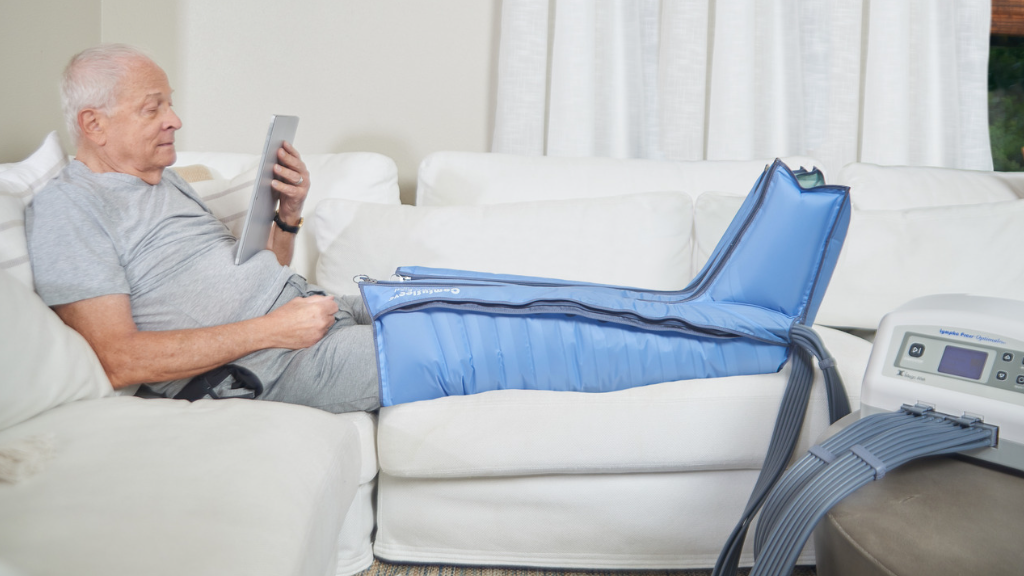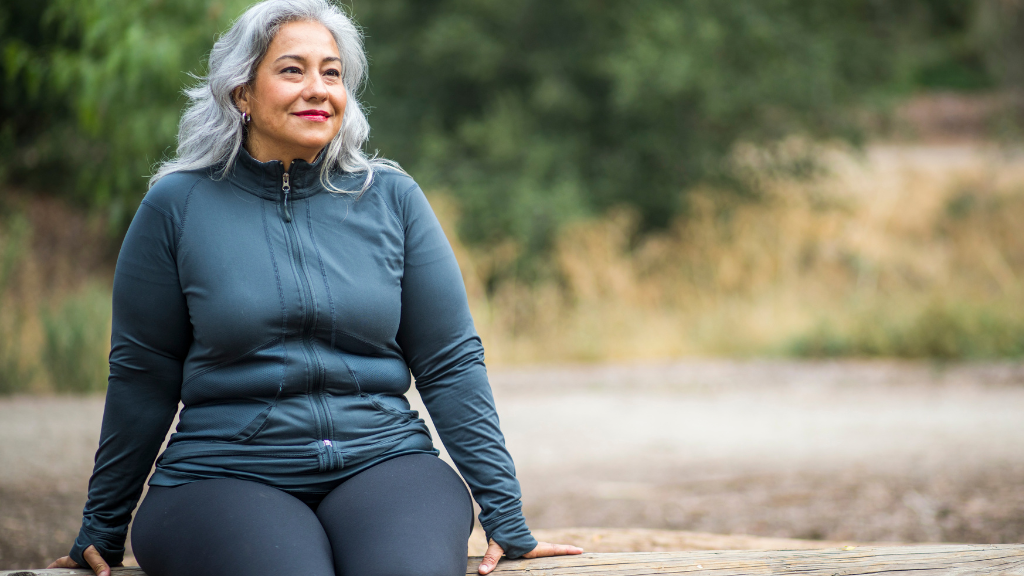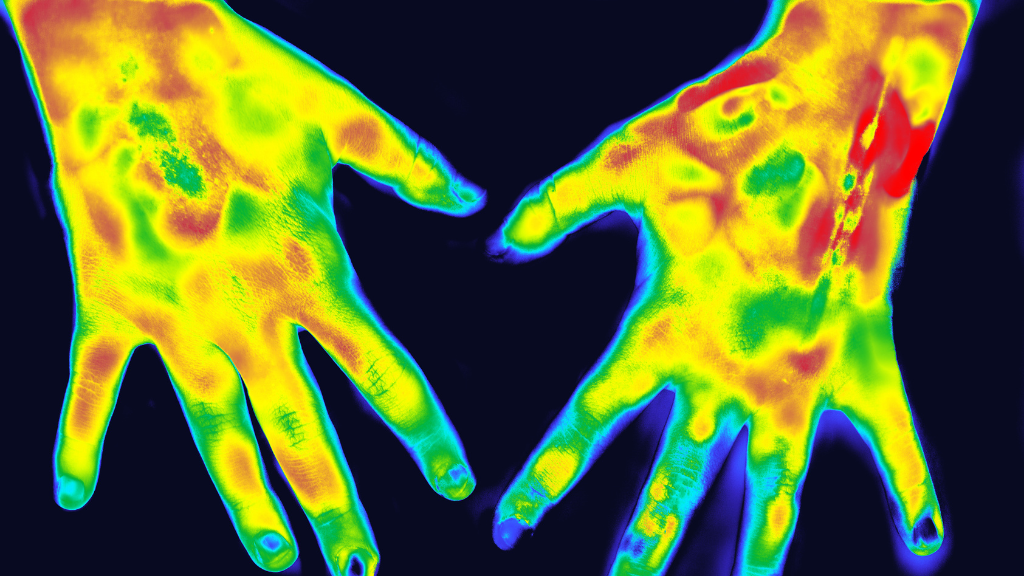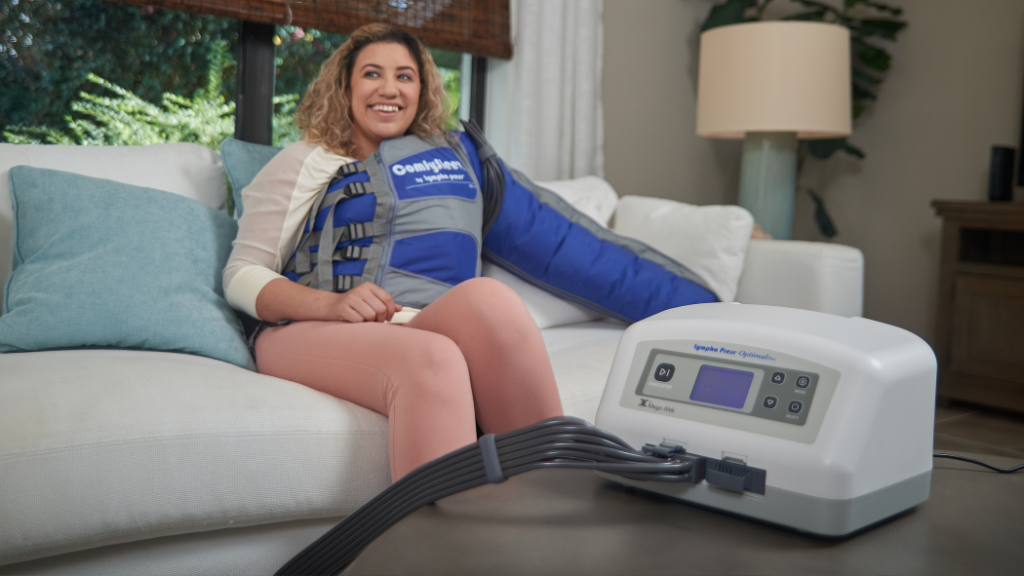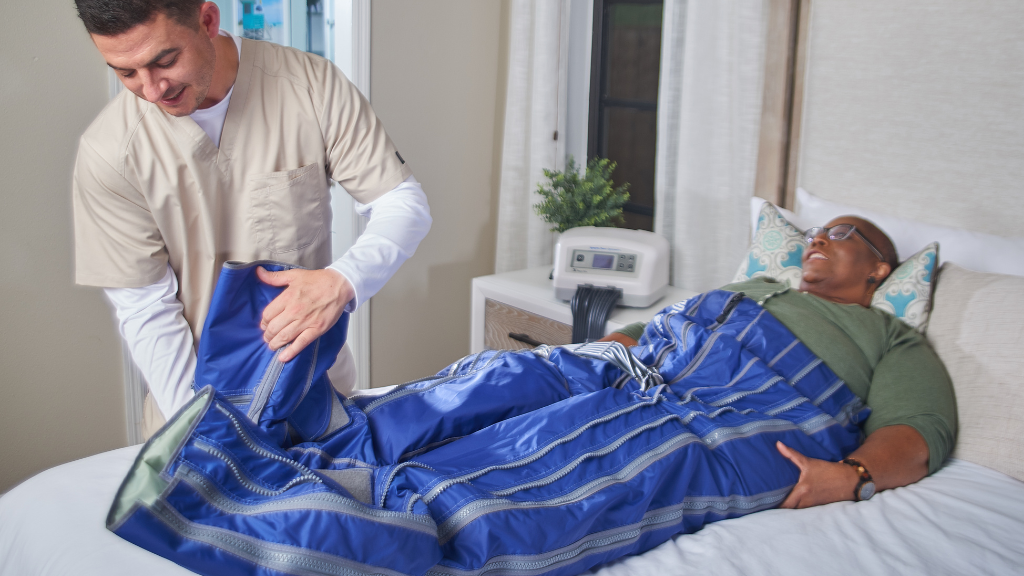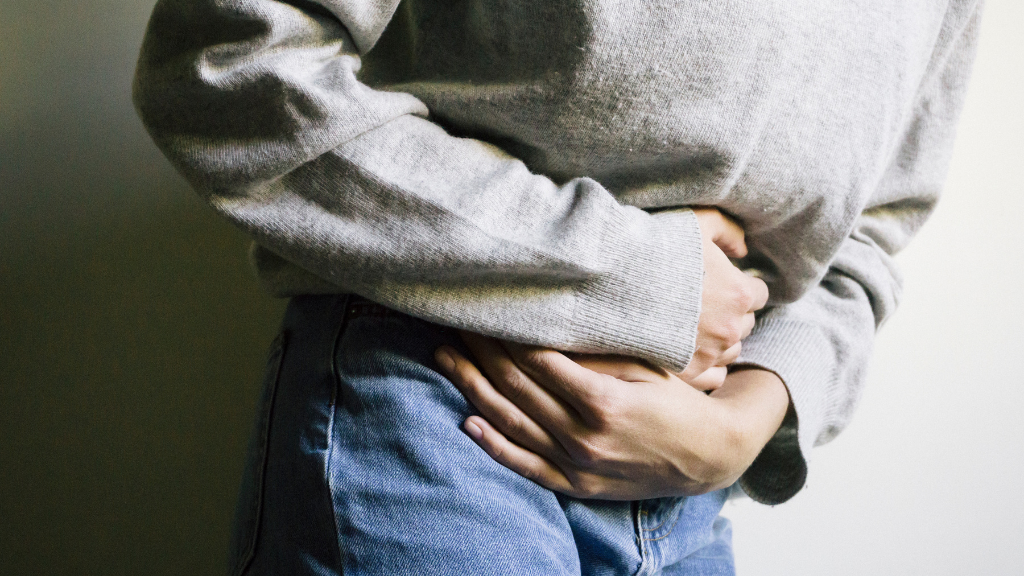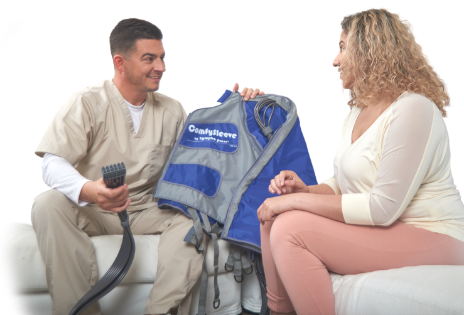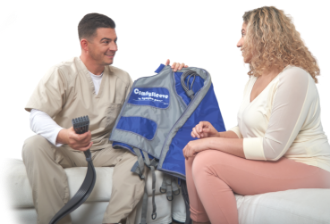Chronic leg swelling and pain from venous insufficiency are prevalent among adults, especially older adults. In fact, venous disease is the most common cause of lymphedema in the Western world. Lymphedema secondary to venous disease is called phlebolymphedema.
Along with the swelling and discomfort, phlebolymphedema tends to get worse over time with inflammation and skin changes. These skin changes can include non-healing wounds, also called venous stasis ulcers. Reducing edema is the key to successfully healing these stubborn wounds.
Vein Disease as a Cause of Edema
The veins in our legs have the challenging task of moving blood against gravity back to the heart. They do this by engaging the calf muscle pump. Every time we take a step, the calf muscle contracts and presses against the deep vein running under it, propelling the blood toward the torso like a “peripheral heart.” Meanwhile, blood is conducted from the superficial veins to the deep veins by perforator veins. The perforator veins contain one-way valves that allow the blood to flow in one direction only.
As long as we are healthy and active, this system works well. However, with age and conditions such as prolonged standing, pregnancy, obesity, or genetic predisposition, the one-way valves in the perforator veins become damaged and fail to close properly. Instead of flowing one way, blood can flow backward into the superficial veins, increasing the pressure inside them. This condition is called chronic venous insufficiency disease (CVI). The increased pressure causes spider veins and varicose veins familiar to many CVI sufferers. It also affects the tiny venules in the capillary beds, causing them to swell, become leaky, and even break open. Excess amounts of fluid are released into the extravascular space, forming edema swelling.
The Development of Lymphedema
Our bodies have a mechanism to deal with edema: the lymphatic system. Tiny lymph capillaries are entwined with the blood vessels, ready and waiting to absorb excess fluid. The lymph capillaries contract and pulse to propel this fluid through progressively larger vessels, routing it through lymph nodes to filter out debris before returning the fluid to the bloodstream.
However, when there is too much fluid for the lymph vessels to handle, they become overfull and no longer function properly. The lymph fluid in that area cannot be absorbed, and the edema becomes chronic. In an opinion paper facilitated by the American Vein and Lymphatic Society, specialty physicians defined chronic swelling as lymphedema. Lymphedema can be caused by many factors, including hereditary malformation of the lymphatic system or damage to the lymphatic system from injury, surgery, radiation therapy, or disease. Phlebolymphedema is a common type of lymphedema caused by failure of the venous system.
Why Phlebolymphedema Is Progressive
In early stages, the swelling of phlebolymphedema might ease somewhat with elevation because the effects of gravity assist blood return to the heart and lymphatic return to the lymph nodes behind the knees and in the groin. For example, swelling may be better in the morning when arising from sleep than it is in the evening, especially in people who need to stand for long periods of time during the day. However, phlebolymphedema is progressive, meaning it tends to get worse over time if it isn’t managed. This is because the breakage of the tiny blood vessels triggers an inflammatory response that becomes chronic and causes fibrosis. Inflammation is increased by the presence of edema, which changes the fluid balance of the cells and prevents nutrients and oxygenation from reaching them. This in turn causes cell death, which further increases the inflammatory response.
Eventually, the lymph vessels, overfilled with stagnant lymph and unable to propel fluid forward, are also damaged by the buildup of fibrosis. When fibrosis creates lymphatic occlusion, or blockage, the chronic edema has advanced to Stage 2 lymphedema, also known as “spontaneously irreversible” lymphedema.
Venous Stasis Ulcers
The inflammation and fibrotic buildup caused by phlebolymphedema also cause skin changes. Skin can lose its elasticity, becoming fragile, itchy, and flaky with dermatitis. It can become hard and woody, with contractures of fibrotic tissue at the ankle, known as lipodermatosclerosis. Erythema, a reddish discoloration caused by dilated and inflamed blood capillaries, may develop. The skin can also develop brown or rust-colored areas (“hemosiderin staining”) resulting from red blood cells leaking from the veins. With so many skin issues as well as the presence of edema, it isn’t surprising that a small bump or cut, a spontaneous opening in the skin, or even scratching an itch can cause a wound that refuses to heal. These wounds are called chronic venous stasis ulcers.
Venous stasis ulcers are very common chronic leg wounds. They usually appear at the ankle or lower leg and can enlarge, become infected, and without treatment, may persist for months or even years. Patients with venous ulcerations experience edema, pain, odor, exudate, frequent infections, and reduced quality of life. Having persistent open wounds as well as edema, pain, and skin changes can make the patient less physically active. Patients who are not physically active, who perhaps spend many hours a day in a chair, are not using their calf muscle pumps to help move venous blood back to the heart.
Indeed, phlebolymphedema is an example of a vicious cycle in which a chronic problem — venous insufficiency — triggers inflammation and fibrotic changes, causing more edema, which causes more inflammation and fibrotic changes, which then causes skin changes and breakdown, non-healing venous ulceration, and reduced physical activity, which further worsens venous insufficiency and edema. The key to breaking this cycle is removing the edema and improving lymphatic and venous circulation.
Treatment For Chronic Venous Stasis Ulcers: Reduce Edema, Improve Circulation
Surgical and minimally invasive procedures, such as venous ablation, can bring substantial improvement and relief. These procedures occlude the perforator veins with the damaged valves, allowing the superficial veins to bypass them and move venous blood to the deep veins by alternate pathways. This reduces reflux and edema production.
Procedures cannot, however, repair the damaged lymph vessels. Compression therapy is a solution that can help reduce and control chronic edema both for patients who experience residual edema after venous ablation procedures and for those patients for whom venous ablation is not indicated.
Compression can be static, relying on muscular motion to move against resistance provided by an inelastic or elastic garment or wrap. Elastic garments are measured to fit and can help contain edema swelling. Inelastic compression can be in the form of an adjustable wrap or bandage. Compression, combined with elevation and exercise, can effectively reduce edema.
However, static compression garments, elevation, and exercise aren’t always sufficient to control and reduce swelling. There are some patients who cannot tolerate static compression or may not wear it consistently due to difficulty donning and doffing. Many patients are sedentary or cannot engage their calf muscle pumps efficiently because they have a shuffling gait or inability to flex their foot due to ankle contracture or another impairment, and thus may not fully benefit from static compression because they do not produce sufficient muscle activity against the compression garment to improve lymph and venous flow.
These patients need dynamic compression in the form of intermittent pneumatic compression (IPC), also called a “lymphedema pump.”
How Lympha Press® Intermittent Pneumatic Compression Helps Heal Venous Ulcers
In a study of the Lympha Press® PCD51 system with patients who had chronic venous stasis ulcers that had been resistant to all other available treatments, all patients experienced wound healing. Most patients experienced complete wound healing at eight weeks, and the remainder achieved substantial progress in wound closure. Patients also reported less discomfort, less exudate, and less odor. This success empowered the patients to be compliant with the twice-daily treatment routine to increase lymphatic and venous circulation.
Lympha Press systems treat chronic venous ulcers by addressing three basic parameters: lymphatic system function, venous circulation, and patient adherence.
Reducing lymphedema makes the environment for healing more favorable. There is less edema causing inflammation and fibrosis, oxygenation is increased and improved, and the edema around the wound bed inhibiting closure is relieved. Lympha Press has been proven to stimulate lymph absorption and increase lymph transport in lymphedema-affected legs during therapy and for at least one hour after the end of a therapy session. This priming therapy assists lymph vessels in contracting and transporting the overload of lymph while also increasing lymphatic absorption at the lymph capillary level, decongesting the area around the wound bed and throughout the treated area.
Lympha Press circumferential sequential compression addresses the venous component by increasing venous return dynamically. The Lympha Press sequential cycle applies external compression to the leg in an action that replicates the action of the calf muscle pump during walking. This is the muscular force that, in healthy individuals, is the driving mechanism for returning venous blood from the legs against gravity to the heart.
The overlapping chambers in each Lympha Press garment are designed based on the principles of lymphatic bandaging. The overlap between each chamber is maintained during compression, helping to prevent reflux, applying smooth and even compression, and assisting venous blood to return against gravity towards the heart.
By using Lympha Press two to three times daily, patients improve both venous and lymphatic return. The external, dynamic intermittent sequential compression provides a “venous assist” to the legs, reducing edema formation while stimulating lymph vessels to increase edema uptake.
Some patients who have phlebolymphedema may have other medical conditions such as mixed venous and arterial insufficiency or neuropathy that can cause discomfort under compression. Lympha Press Smart Technology™ is designed to ensure complete deflation of the garment at each pause interval between inflation cycles. This truly intermittent “compression and release” cycle makes treatment comfortable as well as more efficient, with a better enhancement of venous and lymphatic vessel flow. The treatment pressure is fully adjustable, too, to allow for the individualization of treatment plans.
Ease of use is also important, especially for elderly patients who make up a significant segment of this population. Lympha Press systems are intentionally designed for ease of use in the home environment. A study of Veterans Administration patients using Lympha Press showed that after two years, 87% were still using their Lympha Press as prescribed. This is a remarkably high level of compliance for any home medical device.
Lympha Press garments have a fill-to-fit design, which means there is no need to wrap around the legs snugly to apply compression. Instead, the garments expand with air to meet the patient’s skin and apply the correct level of compression. This makes donning and doffing treatment garments very easy, and practitioners can be assured that patients are receiving the intended therapy.
Hygiene is also important, especially for patients with wounds. Lympha Press has a smooth, nonporous, coated polyurethane surface both inside and out, so it’s easy to wipe it clean. The smooth surface does not attract dander, pet hair, or other frequent hygiene offenders in the home environment.
Our team of dedicated specialists train and set up patients in the home and follow up with the prescribing physician and therapists to ensure that each patient is able to use their Lympha Press system effectively.
For more information about Lympha Press
Lympha Press at-home therapy is easy to use and offers significant symptom relief with results backed by clinical studies. Clinicians treating chronic wounds will find a wide range of therapy options.
We invite you to find the Lympha Press product that’s the perfect fit as you treat the symptoms of phlebolymphedema, chronic venous stasis ulcers, and other lymphatic conditions.
We offer a wide range of informative virtual webinars and patient-oriented roundtables. You are welcome to join us live, or access prior events here.
